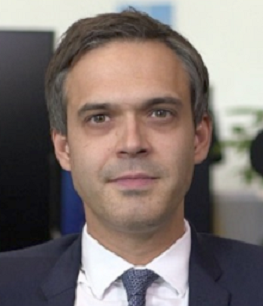May 10, 2021
Eurex
Total Return Futures - How Trading Strategies are Evolving Among Buy and Sell Side
As the TRF segment grows, market participants are using these listed solutions to trade implied repo rates and generate alpha. In a recent Eurex webcast, market participants, representing both the buy and sell side, shared how they are using TRFs as part of their futures trading strategy, and specifically with UCITS funds.
Sell-side View – A listed alternative to TRS delivering cost optimization and investment opportunities
Antoine Porcheret, Director, Equity Trading Strategy, Citi

Total Return Futures (TRFs) on the EURO STOXX 50 Index were introduced in 2016 to provide a listed alternative to the €100 billion OTC Total Return Swaps (TRS) market. In the five years since, TRFs have taken over much of the TRS market. Buyers of TRFs receive the performance of the EURO STOXX 50 price return index, plus 100% of the realized dividends. In return, they pay the interest rate benchmark (EONIA equivalent) plus a spread known as the equity financing rate. The equity financing rate provides investors with unique investment opportunities, both from a carry perspective and in terms of cost optimization.
When an asset manager buys a TRF from a dealer, the dealer hedges the trade by buying physical shares. They then lend these physical shares out to the market and extract an income from it, which is the repo rate. They pass this extra income to the buyer with a lower TRF spread—the higher the repo, the lower the TRF spread. However, while investors receive 100% of realized dividends, the dealer is taxed on physical shares, so there is a dividend mismatch. Dealers therefore pass through the dividend holding cost to the initial buyer via a higher TRF spread and therefore a higher TRF price. The equity financing rate or TRF spread the buyer pays is calculated based on minus repo, plus dividend tax times dividend yield.
The equity financing rate is not constant with time. It is impacted by different drivers on different maturities and is affected by market supply-demand imbalances and dealers’ regulatory constraints. The short term is impacted by securities lending, equity financing transactions, bank balance sheet constraints and equity futures flow. For the longer-term maturities, structured products take over as the main flow on the equity financing rate.
Structured products represent more than $500 billion notional. When dealers trade this product, they have to buy long term forwards to hedge their long-term exposure, thereby lifting equity financing rates and putting buying pressure on these equity financing rates on the back end. When the market goes down, they have to buy even more, lifting long term financing rates further. This was evident during the Covid-19 market crash in March 2020.
New contracts such as TRFs on the FTSE 100, Euro zone banks STOXX Banks EUR Price Index (SX7E) and Euro STOXX Select Dividend 30 (SD3E) bring welcome diversification. For now, the FTSE 100 TRF spreads looks much like the EURO STOXX 50, but that could change if the UK government reintroduces a dividend tax as this would impact the structure of FTSE equity financing rates. Fiscal reform in France could also increase the dividend tax there which will impact the EURO STOXX 50 curve.
The main risk for institutional investors with TRFs is a pure trading risk – if the long-term equity financing rate goes very high, they will suffer a negative mark-to-market of the trade. However, with growing numbers of participants on those types of strategies there is not the same dislocation there would have been 10 or 15 years ago, when only a few players were doing this trade.
Carry trade is the most common use of TRFs by investors and dealers are also using them on a daily basis. Over the next few years, we think that large institutions will increasingly use TRFs for cost optimization. Demand for TRFs came largely from dealers as they looked for a way to hedge and comply with capital constraints from regulation. But it’s also about monetary decisions. The success of autocallable products is mostly due to the hunt for yield of global investors. The more autocallables a firm has, the more hedging is required, leading to more potential dislocation in the financing curve and potentially more opportunities for investment.
Buy-Side View – How TRFs are integrated in a UCITS fund
Amundi is working with Aldrin Wealth Management to launch a dedicated UCITS fund providing absolute return strategies using derivatives both OTC and listed derivatives, including TRFs. AWM is the advisor and distributor of the fund; Amundi acts as the fund manager. Below is a case study exploring how Amundi and AWM integrated TRFs into their fund.
Lautaro Peuch, Structuring and Financial Engineering, Amundi Paris

The adoption of any product innovation goes through three stages: At first the idea seems ridiculous, then it is said to be dangerous, and last it becomes self-evident. The “ridiculous” phase was quick because the firm already had ample experience with total return swaps. From Amundi’s point of view, a listed version of TRS was a natural evolution.
To get through the “dangerous” phase, there was a need to educate, explain and convince users that this product is no more dangerous than any derivative. As with any asset manager, Amundi identified and mapped the risks for the new instrument and defined an appropriate risk framework. These risks were taken into account in ALTO, our proprietary portfolio management system, including the calculation of value at risk and sensitivities. This step prepared us for questions from the Luxembourg regulator the Commission de Surveillance du Secteur Financier (CSSF). The regulator wanted to understand the strategies, as well as the TRF product and its associated risk and to ensure these were clearly explained in the prospectus for investors.
Many departments were involved in the integration project including front office-portfolio management, structuring and quantitative research teams, Amundi Intermediation regarding orders execution, Risk department as well as other support departments (IT, Referential, Middle office), and of course legal and compliance.
Amundi is now in the final “self-evident” phase where TRFs are fully accepted and the firm is ready to launch the fund. Thanks to the innovation the TRF represents, combined with other OTC strategies and their unique positioning, Amundi believes the fund should attract many interest from potential investors.
Regis Lavergne, General Manager Strategy and Investment, Board Member, Aldrin Wealth Management (AWM) Geneva

Regulatory bank constraints are definitely generating market opportunities for clients. Thanks to Eurex, equity repo can be easily traded with listed TRF products. Our solution enables repo yield capture within the funds in order to offer performance higher than the investment grade yield with a lower volatility. In order to deliver its investment objective of EONIA plus 100 bps, the Euro-repo fund implemented two strategies: The fund principle is invested in a portfolio hedge with a six-year TRS maturity; and it uses a slope strategy on Eurex EURO STOXX 50 TRF to offer higher profitability.
The slope strategy benefits from the upward slope of the SX5E repo curve and involves buying short term EURO STOXX 50 TRFs while selling long term EURO STOXX 50 TRF in order to benefit from the carry and the rolldown. The market risk is mainly linked to the potential spread between the level of the EURO STOXX 50 repo for a given maturity with the EURO STOXX 50 repo for a different maturity.
The Amundi Luxembourg Euro-repo fund offer a profitable and liquid strategy combining expertise on the repo market and the TRF products. During the first phase of the COVID crisis the EURO STOXX 50 suffered a drawdown of more than 35% and the Volatility Index (VIX) surged past 85. The fund’s maximum drawdown was -3.663 and the fund had almost completely recovered by the beginning of June 2020, while the EURO STOXX 50 remained 10% below. Aldrin expects the same resilience in other future financial crises.
First published on DerivSource.
